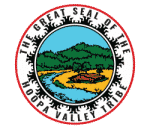Hoopa Tribal Museum
The Hoopa Tribal Museum is a “Living Museum,” in that most of the artifacts and items of cultural patrimony are still actively being used by members of the tribe for tribal ceremonies and functions. The exhibitions are not just for public display. They are still being used for their original intended purposes in an active culture. The museum is unique in the world because this is their core premise and function. The museum is for the Hupa people and not just about them. More than half of the artifacts are owned by local Hupa families on the Reservation the rest belonging to the Hoopa Valley Tribe as a whole.
The Hoopa Tribal Museum has multiple functions. The most obvious being the housing and exhibition of Hupa artifacts. These artifacts include traditional clothing, ceremonial clothing, traditional designs, cooking and eating utensils, hunting/gathering artifacts, dance regalia, hair pieces, war artifacts, early white settler artifacts, traditional contemporary art, traditional jewelry, fishing and hunting implements, artifacts used in traditional games, drumming and gambling implements, storage basketry, and traditional baby baskets and toys.
The Hoopa Tribal Museum provides guided tours for exhibitions within the museum and to three different traditional village sites along the Trinity River. The traditional villages sites of Ta’kimiL ding (Place of the Acorn Feast), Me’dil ding (Place of Canoes), and Diysh Tang a’ding (Place where the albino deer’s face sticks out into the water). Each village has traditional Xontah (houses) and Taiqiwh (sweathouses). Each village has their own history, stories, and ceremonial sites. Portions of these traditional village sites where rebuilt by the tribe in the 1970’s.
The Hupa Language is a part of the Na-Dene Language Family. It is the most geographically widespread language family on the North American continent. From Alaska to Mexico, and from the Pacific Coast to the Great Plains. The thought process of the Hupa Language is very different from English and is very tied to the land and culture. Giving a perspective that English speakers would have never understood on their own. Members of the staff are fluent and can explain the Hupa “thought” process and how it is different from English thought.
All of the staff are Hoopa Valley Tribal members from local families on the Reservation. They have a vast knowledge of Hupa ceremonies, traditions, stories, and histories. These histories include: the creation of the world and universe, the coming of human beings, celestial and human interactions, the arrival of white people, conflicts between groups, teaching stories, funny stories, and contemporary stories from the last hundred years
The museum sponsors traditional dress making classes, dance necklace making classes, Hupa Language classes, bow quiver classes, traditional basketry classes, traditional foods classes, etc… The continuance of the Hupa culture is our objective. Please come and enjoy what we can offer.
Hoopa Tribal Museum
P.O. Box 1348
12500 State Hwy 96
Phone: (530) 625-411-
E-mail: hupamuseum@gmail.com
Curator: Silis-chi-tawn S. Jackson
Curator Aide: Ralph Peters III
Office Worker: Minnie McKelvy
 This is a picture of the traditional Ehs ma: ning ai (Fish Dam), a museum project that was done a few summers ago. The Fish Dam was to provide salmon to the people.
This is a picture of the traditional Ehs ma: ning ai (Fish Dam), a museum project that was done a few summers ago. The Fish Dam was to provide salmon to the people.
 This picture shows the making the lattice work gates on the fish dam using young fir trees and wild grape vine.
This picture shows the making the lattice work gates on the fish dam using young fir trees and wild grape vine.
About Hoopa Valley Tribe
We, the Hoopa Valley Tribe, are a Tribal Government dedicated to protecting and promoting the interests of the Hoopa Valley Indians, and cooperating and collaborating with Federal, State, and local Governments.
Address
Hoopa Valley Tribe
11860 State Hwy 96
PO Box 1348
Hoopa, CA 95546
Phone: 530-625-4211
Fax: (530) 625-4594
Follow Us:
Copyright 2003 - 2020 The Hoopa Valley Tribe
